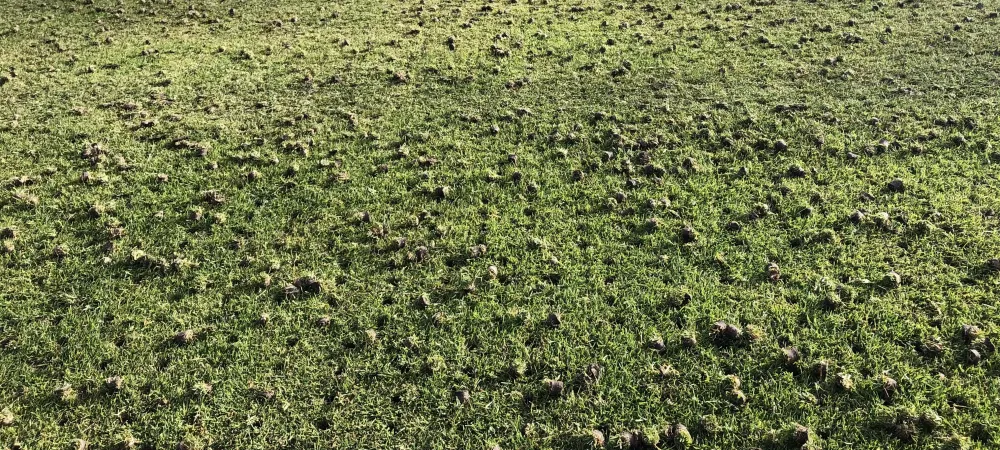How To Aerate Your Lawn: A Step-By-Step Guide

A well-maintained lawn is a source of pride for homeowners in Alabama, Georgia, and South Carolina. One crucial aspect of lawn care that often gets overlooked is aeration. Aerating your lawn can significantly improve its health by allowing nutrients, water, and air to penetrate the soil more effectively. In this comprehensive guide, we'll walk you through the process of properly aerating your lawn step by step.
Step 1: Assess Your Lawn
Before you begin aerating your lawn, take some time to assess its condition. Look for these signs to confirm that your lawn might benefit from core aeration:
- Pooling Water: After a rain shower or watering your lawn, observe if water pools in certain areas rather than being absorbed quickly. This indicates that the soil is compacted and unable to absorb water efficiently.
- Thatch Buildup: Thatch is a layer of dead grass, roots, and organic matter that accumulates between the soil and the grass blades. Excessive thatch layers can hinder water and nutrient absorption, leading to compacted soil.
- Sparse Grass: Areas with thin or sparse grass growth may indicate underlying soil compaction issues. Grass struggles to establish deep roots in compacted soil, resulting in weak growth.
- High-Traffic Areas: Walk around your lawn and visually inspect areas where people commonly walk or play. Look for flattened grass, soil surface that feels hard and compacted underfoot, or areas where grass struggles to grow.
Conduct the Screwdriver Test
Take a standard screwdriver and try pushing it into the soil. If it easily penetrates the soil to a depth of at least 2-3 inches, the soil is likely loose and healthy. However, if you encounter resistance or can't penetrate the soil deeply, it indicates soil compaction.
Step 2: Choose the Right Time
The best time to aerate warm-season grasses like Bermuda, Zoysia, and Centipede in Alabama, Georgia, and South Carolina is during their active growing season in late spring to early summer.
For cool-season grasses, like Fescue, the ideal time to aerate is early fall.
Step 3: Select the Proper Equipment
There are two main types of aerators: spike aerators and plug aerators.
Spike Aerators
Spike aerators feature solid spikes or tines that penetrate the soil when the aerator is pushed or rolled over the lawn. They create holes in the soil by pushing the soil aside, creating channels for air, water, and nutrients to reach the grassroots.
- Effectiveness: Spike aerators primarily aerate the top layer of soil, offering limited relief from soil compaction compared to plug aerators.
- Pros: They are usually more affordable, easy to use, and can be suitable for smaller lawns or light aeration needs.
- Cons: Spike aerators may contribute to soil compaction around the holes they create, and they don't remove soil cores, which are beneficial in plug aeration.
Plug Aerators (Core Aerators)
Plug aerators have hollow tines that remove small cores or plugs of soil from the lawn during aeration. They pull out soil cores, creating open channels that allow for better air, water, and nutrient penetration deep into the soil.
- Effectiveness: Plug aerators are more effective at relieving soil compaction and promoting healthier root growth compared to spike aerators.
- Pros: They provide deep soil aeration, reduce compaction, and improve overall soil health and grass growth.
- Cons: Plug aerators are typically more expensive, heavier, and require more effort to use compared to spike aerators. They also leave soil cores on the lawn surface, which may require additional cleanup, though they do break down quickly.
Choosing Between Spike and Plug Aerators
- Lawn Size and Needs: For smaller lawns or light aeration needs, a spike aerator may suffice. However, for larger lawns or areas with significant soil compaction, a plug aerator is more effective.
- Soil Type: Consider your soil type and level of compaction. Clay soils or areas with heavy foot traffic benefit greatly from plug aerators due to their deeper aeration capabilities.
- Budget and Convenience: Spike aerators are more budget-friendly and easier to use, making them suitable for DIY homeowners or those with limited budgets. Plug aerators, while more expensive and heavier, offer superior soil aeration benefits in the long run.
Spike aerators puncture the soil with solid spikes and are suitable for light aeration needs, while plug aerators remove soil cores and provide deeper, more effective aeration, making them ideal for improving overall soil health and combating soil compaction.
Step 4: Prepare Your Lawn
Preparing your lawn properly before aerating is essential to ensure the aeration process is effective and beneficial for your grass and soil.
- A day or two before aerating, mow your lawn to a slightly lower-than-usual height. This helps the aerator penetrate the soil more effectively.
- Water your lawn thoroughly the day before aeration. This ensures that the soil is adequately hydrated and not too dry or too wet, making it easier for the aerator to penetrate the soil.
- Remove any debris, such as branches, rocks, or large clumps of thatch, from the lawn surface. These obstacles can interfere with the aeration process and the performance of the aerator.
- If you have an underground irrigation system, mark the locations of sprinkler heads or any other components to avoid damaging them during aeration.
- Identify and mark any other obstacles in your lawn, such as utility lines, tree roots, or landscaping features, to ensure safe and smooth aeration.
Step 5: Aerating Your Lawn
- Read the Manual: Before starting, read the instruction manual provided with the core aerator. Familiarize yourself with its controls, safety features, and operational guidelines.
- Wear Protective Gear: Wear appropriate clothing, sturdy shoes, and eye protection when operating the aerator to ensure your safety.
- Adjust Tine Depth: Most core aerators have adjustable tine depth settings. Set the tines to penetrate the soil to a depth of 1-3 inches, depending on the severity of soil compaction.
- Inspect and Lubricate: Check the aerator for any damage or loose parts. Lubricate moving parts if necessary to ensure smooth operation.
- Divide the Lawn: If you have a large lawn, divide it into manageable sections. Start aerating from one end and work your way systematically to ensure complete coverage without missing any areas.
- Overlap Passes: Overlap each pass slightly (about 25-50%) to ensure that the entire lawn is aerated evenly.
- Move Methodically: Walk at a steady pace while operating the aerator. Avoid sudden stops or jerky movements to maintain consistent aeration depth and coverage.
- Focus on Compacted Areas: Pay extra attention to areas with heavy foot traffic, compacted soil, or thin grass growth. Aerating these areas thoroughly helps alleviate compaction and promote healthier grass.
- Clean Up: Some core aerators come with a collection bin to gather the soil cores pulled out during aeration. If your aerator has this feature, empty the bin periodically to prevent clogging and facilitate cleanup.
- Clean and Maintain: Once you've finished aerating, clean the aerator thoroughly to remove any debris or soil buildup. Follow the manufacturer's guidelines for maintenance and storage to prolong the machine's lifespan.
By following these steps and using the core aerator correctly, you can effectively aerate your lawn, improve soil health, and promote lush, vibrant grass growth.
Step 6: Post-Aeration Care
Once you are done aerating your turf, you should:
Leave Soil Cores
After aerating, leave the soil plugs on the lawn surface. They will break down naturally and contribute valuable nutrients back to the soil.
Watering
After aerating, water your lawn lightly but thoroughly. This helps the soil settle and facilitates the breakdown of soil cores left on the surface. Maintain regular watering practices according to your grass type and local climate conditions. Adequate moisture is essential for grass recovery and root development.
Fertilization
Consider applying a balanced fertilizer after aerating. Aeration creates open channels for nutrients to penetrate the soil, making fertilization more effective. Use a fertilizer formulation appropriate for your grass type and follow the recommended application rates. Avoid over-fertilizing, as it can stress the grass.
Overseeding (if necessary)
If your lawn has thin or bare areas, consider overseeding immediately after aeration. The open soil provides an ideal environment for new grass seeds to establish. Choose high-quality grass seeds suitable for your climate and soil conditions. Spread the seeds evenly over the aerated lawn and lightly rake to ensure good seed-to-soil contact.
Soil Amendments (optional)
Consider topdressing your lawn with a thin layer of compost or topsoil after aeration. This helps fill in aeration holes, improves soil structure, and provides additional nutrients. You should also conduct a soil test to determine if your lawn needs specific soil amendments, such as lime for pH adjustment or additional nutrients based on soil deficiencies.
Avoid Heavy Traffic
Avoid heavy foot traffic on the aerated lawn until the grass has fully recovered. Walking or playing on the lawn too soon can disrupt the soil and impede grass growth.
Observe
Keep a close eye on your lawn in the weeks following aeration. Monitor grass growth, color, and overall health to ensure that the aeration process has been beneficial. If you notice any areas of stress, pest infestations, or weed growth, take prompt action to address these issues. Healthy soil and grass are less susceptible to problems.
Regular Maintenance
Resume regular mowing according to recommended heights for your grass type. Avoid mowing too short, especially immediately after aeration, to allow grass roots to establish.
Plan to aerate your lawn annually or biennially to maintain soil health and promote strong grass growth. Regular aeration prevents soil compaction and allows for better nutrient absorption.
Call Lawn Care Professionals
While aerating your lawn yourself can be rewarding, letting professional lawn care technicians handle your lawn aeration simplifies your maintenance routine and ensures optimal results. With our expertise and specialized equipment, professionals such as Unlimited Lawn Care™ can efficiently aerate your lawn, relieving soil compaction and promoting healthier grass growth. Save time and effort while enjoying a lush, vibrant lawn—trust the experts for your aeration needs and experience the benefits of professional care. Contact our team of experienced lawn technicians today!
